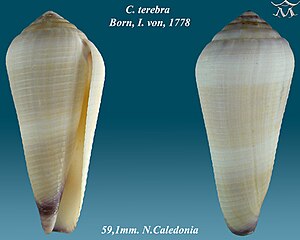Conus terebra
| Conus terebra | ||||||||||||
|---|---|---|---|---|---|---|---|---|---|---|---|---|

Case from Conus terebra |
||||||||||||
| Systematics | ||||||||||||
|
||||||||||||
| Scientific name | ||||||||||||
| Conus terebra | ||||||||||||
| Born , 1778 |
Conus terebra ( "Drill-cone") is a screw from the family of the cone snails (genus Conus ), which in Indopazifik is widespread and of Schopf worms fed (Terebellidae).
features
Conus terebra bears a medium-sized to large, moderately firm to firm snail shell , which reaches 4 to 10 cm in length in adult snails. The circumference of the body is conical to narrowly conical, the outline on the shoulder convex and otherwise straight, sometimes concave in the middle. The shoulder is rounded and sometimes only indistinctly separated from the thread. The thread is usually medium high, occasionally low, its outline is convex. The Protoconch is multi-threaded and measures a maximum of 0.8 mm. The first 3 to 5 whorls of the teleoconch are covered with tubercles. The seam ramps of the Teleoconch are slightly convex to slightly concave with 1 to 3 to 4 increasing wide spiral grooves and additional stripes or with numerous stripes. The area around the body is covered from the base to the shoulder with alternately fine ribs that run in a spiral at alternating intervals, and spiral threads can run along the spaces between them.
The basic color of the housing is white to bluish-white. The perimeter of the body has a wide spiral band on either side of the middle, varying from violet-gray to yellow-brown. The base can be colored purple or yellow. The protoconch and the sewing ramps of the following 1 to 2 whorls of the Teleoconch are colored bluish-purple, the later sewing ramps are colored irregularly brown. The inside of the case mouth is white, pale blue to purple, the front edge purple on specimens with a purple base.
The thick, opaque and with axial ribs occupied Periostracum is dark brown, in large specimens even darker and rough.
The top of the foot is greyish-yellow with gray and dark yellow to orange or reddish-brown spots and merges into a monochrome yellowish-gray at the rear lateral edge areas. There is a black spot under the operculum and a large, continuous or interrupted black transverse band in the front section, followed by a yellow-brown area in the middle. The sole of the foot is pale yellow and the back is washed with dark yellow. The rostrum is pale yellow to light orange or light brown, distally sometimes dark yellow. The proboscis is yellow, the penis white. The long antennae are pale yellow to orange. The broad, wide-mouthed siphon is yellow in the front part and merges into white towards the front, whereby the distal edge can be orange, and the adjacent part has a black, yellow and broad gray to black transverse band, and the proximal section is yellow with gray Stains.
The radula teeth connected to a poison gland have a barb on the tip and a cutting edge on the opposite side. They are sawn a long way from the top to past the center of the shaft, ending in a backward-pointing prong. There is a protruding spur at the base.
distribution and habitat
Conus terebra is widespread in the Indo-Pacific - the subspecies terebra from the coast of East Africa to the Marquesas Islands, Amami Islands and Australia , the subspecies thomasi in the Red Sea and in the Gulf of Aden .
Conus terebra lives at depths of half a meter to about 20 meters of coral reefs and Riffkronen in fine sand with or without sea grass and coral rubble, both in sheltered spots under coral rocks and on exposed rocks.
Development cycle
Like all cone snails, Conus terebra is separate sexes, and the male mates with the female with his penis . The eggs in the egg shell develop into Veliger larvae, which after a free-swimming phase sink down as plankton-eating zooplankton and metamorphose into crawling snails .
nutrition
The prey of Conus terebra consists of sedentary Vielborstern the family of Schopf worms (Terebellidae), which he shares with his Radulazähnen stands and using the poison out of his venom gland immobilized.
literature
- George Washington Tryon: Manual of Conchology, structural and systematic, with illustrations of the species , vol. VI; Academy of Natural Sciences, Philadelphia 1884. C [onus] terebra Born., P. 80.
- Jerry G. Walls: Cone Shells: A Synopsis of the Living Conidae TFH Publications, Neptune (New Jersey) 1979. p. 804.
- Dieter Röckel, Werner Korn, Alan J. Kohn: Manual of the Living Conidae Vol. 1: Indo-Pacific Region . Verlag Christa Hemmen, Wiesbaden 1995. The texts on the individual cone snail species of the Indo-Pacific are published on The Conus Biodiversity website with the permission of the authors (see web links).
Web links
- The Conus Biodiversity Website: Conus terebra Born, 1778
- Underwater Kwajalein: Conus terebra Hwass in Bruguière, 1792
Individual evidence
- ^ Alan Kohn, in: Claus Nielsen (2013): Life cycle evolution: was the eumetazoan ancestor a holopelagic, planktotrophic gastraea? . BMC Evolutionary Biology 13, Art. 171, p. 9. Figure 8. The occurrence of “direct” development in the gastropod genus Conus. Conus terebra : planktonic larvae, planktotrophic.